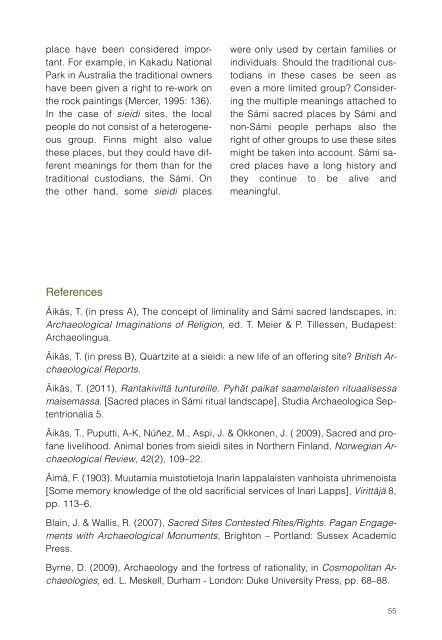The Diversity of Sacred Lands in Europe - IUCN
The Diversity of Sacred Lands in Europe - IUCN
The Diversity of Sacred Lands in Europe - IUCN
Create successful ePaper yourself
Turn your PDF publications into a flip-book with our unique Google optimized e-Paper software.
place have been considered important.<br />
For example, <strong>in</strong> Kakadu National<br />
Park <strong>in</strong> Australia the traditional owners<br />
have been given a right to re-work on<br />
the rock pa<strong>in</strong>t<strong>in</strong>gs (Mercer, 1995: 136).<br />
In the case <strong>of</strong> sieidi sites, the local<br />
people do not consist <strong>of</strong> a heterogeneous<br />
group. F<strong>in</strong>ns might also value<br />
these places, but they could have different<br />
mean<strong>in</strong>gs for them than for the<br />
traditional custodians, the Sámi. On<br />
the other hand, some sieidi places<br />
were only used by certa<strong>in</strong> families or<br />
<strong>in</strong>dividuals. Should the traditional custodians<br />
<strong>in</strong> these cases be seen as<br />
even a more limited group? Consider<strong>in</strong>g<br />
the multiple mean<strong>in</strong>gs attached to<br />
the Sámi sacred places by Sámi and<br />
non-Sámi people perhaps also the<br />
right <strong>of</strong> other groups to use these sites<br />
might be taken <strong>in</strong>to account. Sámi sacred<br />
places have a long history and<br />
they cont<strong>in</strong>ue to be alive and<br />
mean<strong>in</strong>gful.<br />
References<br />
Äikäs, T. (<strong>in</strong> press A), <strong>The</strong> concept <strong>of</strong> lim<strong>in</strong>ality and Sámi sacred landscapes, <strong>in</strong>:<br />
Archaeological Imag<strong>in</strong>ations <strong>of</strong> Religion, ed. T. Meier & P. Tillessen, Budapest:<br />
Archaeol<strong>in</strong>gua.<br />
Äikäs, T. (<strong>in</strong> press B), Quartzite at a sieidi: a new life <strong>of</strong> an <strong>of</strong>fer<strong>in</strong>g site? British Archaeological<br />
Reports.<br />
Äikäs, T. (2011), Rantakiviltä tuntureille. Pyhät paikat saamelaisten rituaalisessa<br />
maisemassa. [<strong>Sacred</strong> places <strong>in</strong> Sámi ritual landscape], Studia Archaeologica Septentrionalia<br />
5.<br />
Äikäs, T., Puputti, A-K, Núñez, M., Aspi, J. & Okkonen, J. ( 2009), <strong>Sacred</strong> and pr<strong>of</strong>ane<br />
livelihood. Animal bones from sieidi sites <strong>in</strong> Northern F<strong>in</strong>land, Norwegian Archaeological<br />
Review, 42(2), 109–22.<br />
Äimä, F. (1903). Muutamia muistotietoja Inar<strong>in</strong> lappalaisten vanhoista uhrimenoista<br />
[Some memory knowledge <strong>of</strong> the old sacrificial services <strong>of</strong> Inari Lapps], Virittäjä 8,<br />
pp. 113–6.<br />
Bla<strong>in</strong>, J. & Wallis, R. (2007), <strong>Sacred</strong> Sites Contested Rites/Rights. Pagan Engagements<br />
with Archaeological Monuments, Brighton – Portland: Sussex Academic<br />
Press.<br />
Byrne, D. (2009), Archaeology and the fortress <strong>of</strong> rationality, <strong>in</strong> Cosmopolitan Archaeologies,<br />
ed. L. Meskell, Durham - London: Duke University Press, pp. 68–88.<br />
55













